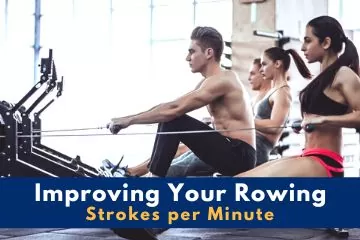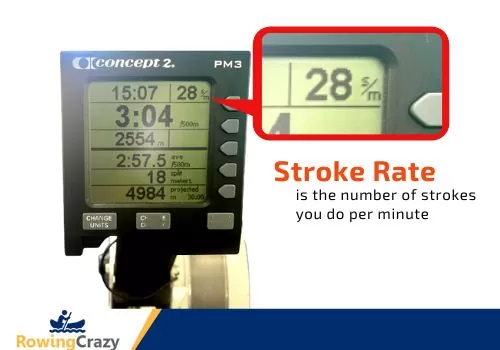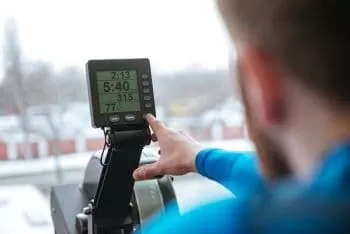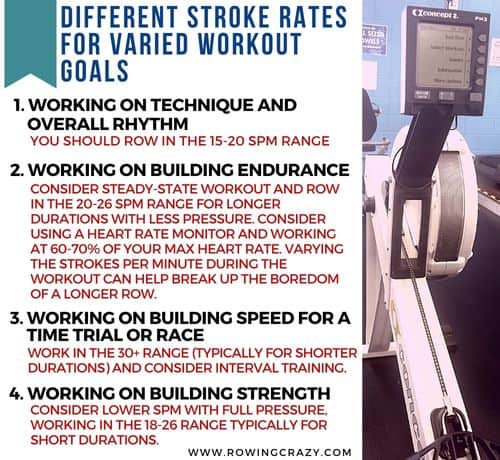
It is a common misconception that moving your body faster up and down the slide with a higher stroke rate will provide a better workout and make you a faster, better or more powerful rower.
Stroke rate on the indoor rower is not a measure of power, and moving our body faster does not always equate to more power. So why then do we care about our strokes per minute on a rowing machine, and what exactly does it mean to improve it?
Stroke Rate Defined
Stroke rate is the number of strokes you do per minute. In simpler terms, it is the number of times your seat goes up and down the slide within a minute.

When your body moves very quickly through the rowing stroke (read more on how to improve your split time ), your stroke rate increases, and when your body’s movement slows down, the number decreases.
What Is a Good Strokes per Minute on a Rowing Machine?
What is the ideal stroke rate for rowing on a rowing machine?
There is not a simple answer to this question. It depends on many factors, including the following:
- The rower’s fitness level
- The rower’s technique/form, and
- The goal of the workout.
What Is the Average Rowing SPM on a Rowing Machine?
Typical stroke rate ranges widely from 18-30 strokes per minute (SPM) for training workouts and from 30-38 SPM for race pace.
So does “improving” your stroke rate mean increasing the number of strokes per minute?
No!
Once again, stroke rate is not a measure of power or how hard one is working. Improving stroke rate refers to consistency and control.
- Improving your rowing SPM means learning at what stroke rate you can produce the most power (lowest split time or highest watts) and maintaining it the longest without fatigue.
- Learning to control your stroke rate allows for a more effective workout to help you reach your goals without burning out or fatiguing too quickly.
- In a “race” or “time trial,” having a good awareness of your effectiveness at a specific stroke rate allows you to plan ahead, produce the most power throughout, and still leave something in the tank for the last 250-500 meters.
How Does Your Fitness Level Impact Stroke Rate?
Rowing at a very high stroke rate, with your body moving very fast, expends more energy. If your cardio/fitness level does not meet the expenditure needs, your body will burn out and fatigue before you finish the workout.

On the other end of the spectrum, you might be rowing at a very low stroke rate but still trying to produce your ideal split times or wattage. If your strength/fitness level does not meet the expenditure needs, your body (or most likely legs) will burn out and fatigue before you complete your workout.
It means that you need to know how your body performs at different stroke rates because this awareness is crucial in helping you plan your workout accordingly. Being able to control and maintain the desired strokes per minute helps to maintain power and avoid fatigue for the duration of the workout.
Watch below experienced erg rower Max Secunda:
What Is the Connection between Stroke Rate and Rowing Form or Technique?
The connection is significant! The faster you move, the more difficult it is to maintain your proper rowing form/technique. New rowers (and some not-so-new rowers) often find that when they try to increase their stroke rate, their form begins to fall apart.
Why is this so?

The ideal ratio of Drive:Recovery is 1:2 or 1:3, which means that you should take twice (or thrice) longer to recover than the time you performed the drive. What happens is that often, this ratio changes to 1:1 or 2:1.
When form falls apart and/or the ratio changes, efficiency is lost and therefore power is lost (splits increase or wattage drops). And if you are rowing for distance ( see our distance calculator ), it will take much longer to reach your goal.
If you are aware of the ideal stroke rate that allows you to maintain your proper rowing technique, every stroke you take will be more efficient and capable in generating more power to add on the meters.
What Are the Different Stroke Rates for Varied Workout Goals?
You might be wondering what a good target stroke rate is. There are varied stroke rates for varied workout goals, as you will see below. If you are –

- Working on technique and overall rhythm– you should row in the 15-20 SPM range
- Working on building endurance– consider steady-state workout and row in the 20-26 SPM range for longer durations with less pressure. Consider using a heart rate monitor and working at 60-70% of your max heart rate. Varying the strokes per minute during the workout can help break up the boredom of a longer row.
- Working on building speed for a time trial or race– work in the 30+ range (typically for shorter durations) and consider interval training.
- Working on building strength– consider lower SPM with full pressure, working in the 18-26 range typically for short durations.
Watch our video on Correct Rowing Machine Form with Olympic Rower Rachael Taylor:
How Can I Improve My Stroke Rate?
- Work on control– You must be able to get to a desired number/SPM while still maintaining your proper rowing form/technique and a steady split or wattage. Varying your stroke rate helps you learn control. Adjustments when building speed should be made on the drive portion of the stroke, not with a quicker recovery.
- Example workout: Stroke Rate Pyramid, SPM 16-18-20-22-24-26-24-22-20-18-16.Pay attention to your Stroke Rate as well as your Split during this workout. Begin rowing at 16 SPM with medium pressure (maintain a perceived effort of 5 on a scale of 0-10). Every minute, increase your stroke rate by 2. Work up to 26, then back down again. Maintain medium pressure and a somewhat consistent split throughout.
- Work on consistency– You must be able to maintain a desired stroke rate for an extended period. Each stroke needs to be consistent with the same ratio of Drive:Recovery. Counting or repeating a phrase during your stroke can be helpful such as “I got this” with “I” on the drive and “got this” on the recovery.
- Example workout: Consistent Row, SPM 22 x 5 minutes plus 5 minutes with a pace boat (setting available on some rowing machines).Choose a Stroke Rate that is comfortable for you, allowing you to maintain form and avoid fatigue. Say, you choose 22. Practice maintaining this stroke rate and a consistent split time for the entire 5 minutes. After a 2-minute rest break, set your monitor with a pace boat, using the split time you maintained in your last piece and complete another 5 minutes. If 5 minutes is too much to maintain, you can break it down into smaller intervals (example: 2 or 3 minutes at a time).
Problem Solving and FAQ
1. When I increase my stroke rate, my split time increases (power drops). What can I do to improve?
Time for a form check!
- Are you getting into a strong catch position?
- Is your body moving in the correct sequence? It should be legs/body/arms/arms/body/legs. Learn more about correct rowing rhythm and technique here.
- Do you have an explosive drive – pushing through your legs with pressure through your heels, with your core tight in a body-over position as you should?
- Is your Drive:Recovery ratio 1:2 or 1:3? It should take you 2-3x longer to come up the slide on the recovery. This means you should keep your legs straight a little longer, let your arms extend fully, then pivot your body over, followed by bending of the knees. Avoid rushing the recovery- this phase is for recovering from your powerful drive.
- Are you getting stuck or pausing at the finish? The transition should be fluid with no pause, try moving your arms away from your body a bit quicker.
Practice this:
- Explosive drives– Legs-only rowing. Begin in a strong catch position. While maintaining arms away and body-over position with your core engaged, drive with your legs, transferring the pressure from your toes through your heels until your legs are extended. When done correctly, you should feel yourself getting light on your seat. Maintain this arms/body position and slowly return to the catch and repeat.
- Pause drill– Arms away/body-over position. Row with a pause during the recovery when you get into the body-over position with arms away. This promotes quick arms away to prevent getting stuck at the finish. It also helps restore the Drive:Recovery ratio by retraining you to keep your legs down a little longer until you get in the body-over position.
- Row slow! Do some slow rowing to get faster. Rowing at a lower stroke rate helps to expose the weak links of your stroke.
2. My stroke rate is all over the place when I row. How can I make my workout more effective?
Try some rowing workouts vs “just row”. The rowing workouts given above as examples for improving control and consistency are a good place to start. You can find many goal-oriented rowing workouts online, and depending on your rowing machine/erg, there may be some programmed into your monitor.
Time for a form check (read through the tips above)! Pay close attention to that Drive:Recovery ratio. Sometimes, counting during the stroke can be beneficial to improve consistency.
3. I’m new to rowing and have no idea what stroke rate to row at. Where should I begin?
- Begin slow (less than 18 SPM) while working on rowing form/technique. Practice, practice, practice.
- Consider rowing drills, including the PICK drill. ( You also might like to read more on the rowing pick drill here)
- Once you master rowing form, begin to work on control and consistency as discussed above.
Watch my above video to learn how to do the Pick Drill
4. I would like to do my first 1K or 2K time trial/test. What stroke rate should I use, and how do I know the best plan for me?
- Determine the following: (prior to your test day- and it may take multiple workouts)
- What is the highest stroke rate you can row while still maintaining your form? An upward build workout is helpful for determining this- begin at 18SPM and build by 2 every 1 minute.
- At what stroke rate can you generate the most power? An upward build workout with full pressure is helpful for determining this.
- What stroke rate can you maintain power for an extended period of time? Longer intervals can be helpful in determining this. Begin at a 26 or 28, row a 3-5 minute interval at full pressure, then assess your split and how you feel after a sufficient rest break. If that SR was easily sustainable, increase by 2 and do another 3-5 minutes, then reassess and adjust again. If at any point you are not able to maintain the SR or Split drops, back down your strokes per minute by 2. Once you determine your “ideal” SR, interval workouts at this SR can help you become more consistent with it and build your endurance to maintain it.
- During your “test” do not go above your rowing speed in #1. Spend most of the race at #3, and begin your first 10-20 strokes and your last 250-500 meters at #2.
5. Do I really need to increase my stroke rate?
The simple answer is no. There is really no reason to “move faster” if you are comfortable rowing at a certain stroke rate, able to maintain good rowing technique, producing the power you want, and getting a good workout.
However, if you are having an issue with any of these factors, then maybe you need to increase or decrease your SR. More importantly, you should work on control and consistency and re-evaluate.
Most of all, enjoy the row!
Written by Laura Tanley – RowingCrazy.com
Certified Indoor Rowing & Erg Instructor (UCanRow2), Experienced Indoor & On-the-Water Rower & Licensed Physical Therapist
Laura is a mother of two, Certified Indoor Rowing Instructor, Licensed Physical Therapist with concentration in Orthopedics and Vestibular Rehab. Laura has years of rowing experience both indoor and on the water. She is excited to join to share her knowledge with the indoor rowing community.






Pingback: Strength Training for Rowing: My Personal Tips & Workouts